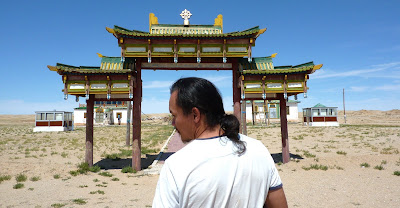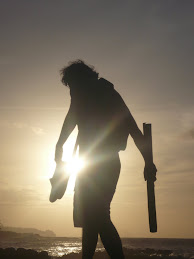
RICK ASKS BUDDHA PERMISSION TO ENTER
Early start today for a special treat... we are off to visit the Hamariin Hiid Inergiin Tow Hysliin Uul Energy Center in the Gobi Desert.
We stack all our bags and hop into a mini-van waiting outside for us, then head out of Sainshand towards Erdene.
The Gobi landscape is pretty flat and featureless, though by the meandering dunescapes we can tell that at one time this land was shaped by water. The recent rains this year have brought forth a flush of greenery, though the sparse spacing between each clump of shrubbery shows just how little water is available here.
Now however, the low dunes are clearly shaped by wind sweeping across the gently undulating plains, keeping everything that does grow low to the ground, clinging stubbornly to its patch of sandy soil.
HARMUG PROLIFERATES IN THE SANDY DESERT SOILS
We stop a short way out of town as Minde spots some Harmag, the Gobi fruit he has been telling us about for the last few kilometers, a tiny, succulent red berry growing on a spiny shrub clumping over little sandy islands in the dessert. Handfulls of berries later, we are still grinning at the tart taste as we hit the road again.
Cracking in the exposed earth tells us there is a higher clay content here, and water flows can clearly be seen in little erosion gullies filled with finer sand particles, often lined with a dominant plant species following the water lines. Every now and then we cross a larger dry river bed at the low point in the shallow basin, and trees cluster along the dry river banks, meandering along the larger water flows into the distance.
The sandy dunes begin to erupt with volcanic bassalt, molten bombs that were spewed ages ago, then the white sands turn to a rich red colour as we near the ancient volcanic core.
CHANGING LANDSCAPE AS WE NEAR THE ENERGY CENTER
Even with the higher mineral content in the volcanic soils here, the low rainfall is not still enough to support a significant increase in plant life. The howling winds and water runoff in the spring have cut some small valleys here, providing some sheltered spots where trees can spring up; we are shown again what a marked difference wind shelter makes in plant growth out here.
The Energy Center is a Bhuddist temple built on an ancient volcano.
Mongolian heads of state, business leaders, and even the Japanese Prime Minister all make regular treks here to re-energize… one of only two energy centers in the world, it is said that this place is located at the confluence of geographic energy meridians, and one can absorb some of this energetic goodness by simply standing and opening yourself to receiving this energy.
Minde tells us that this is Mongolia’s best-kept secret, one that perhaps should not have been shared with the outsde world.
During Socialism times, locals kept this sacred place hidden from Government. Buddhist monks have been coming to this place for eons to meditate, and I can feel the different energy as soon as we step out of the car.
SAURAG
We walk up to the entrance and as we crest the hill, the temple reveals itself to us. Saurags, or buddhist shrines that look like Mongolian Wrestler’s hats, are built around the perimeter.
A pair of Buddha eyes painted onto the wall of the main entrance watch us silently as we descend the pathway towards the southern gate; this is the gate that lay people enter from. Dignitaries and important people, enter from the East, if you are sick you enter from the North, and I can’t quite remember what the West gate was designated for…
Our driver walks us through all the protocols of offerings and tradition and prayer – light incense here, ask for permission to enter there, throw rice in the air here, dip your finger and throw vodka into the air there – until we make our way over to a circle of red stone; the Energy Center.
GOOD, GOOD, GOOD, GOOD VIBRATIONS...
Shoes off, center yourself, and enter the circle to sit, open-palms to absorb all the good vibes. Thus re-energized, we move towards the row of stone bowls filled with water leading up to an oversized stone table upon which three stone bowls full of rice grains sit.
...RICK LOOKS LIKE HE JUST ATE SOME OF BUDDHA'S RICE...
WHICH I AM PRETTY SURE HE DID!
We pause here to offer some of the rice we have brought into each of the bowls, sit at the table and munch on a few grains ourselves – sharing a meal with the Buddha.
Next we climb the hill to a large stone ovod at the head of the temple grounds, stopping to pick up a stone to toss on the pile as we do our three clockwise circles to give thanks for our safe journeys thus far, and ask for guidance and protection as we continue. The blue cloths tied around the flagpole at the center of the pile flap in breeze, their shredding threads sending our prayers off into the breeze.
In the distance to the Northwest of the ovod a low mountain peak winks at us, and we are instructed to take a swig of the blue vodka bottle that our host has bought with us, and throw some in the air to the mountain to say thanks for the good vibes and re-energizing.
Behind the ovod is a stone monument with a musical verse and lyrics inscribed in its side. We join hands and sing together, a song of praise and love dedicated to an unseen Sweetheart, or perhaps, to an unseen Deity.
One more ceremony to complete before we leave the temple grounds, as we walk back towards the south gate, another stone circle lies in our path. This one, we are told, is a dream machine – we enter the circle, take the rocks which are strewn about within, and arrange them into representations of what we want to wish for.
As we leave the temple, the Buddha eyes watch again until we disappear from sight and head off to the meditation caves 800m away.
In the distance to the Northwest of the ovod a low mountain peak winks at us, and we are instructed to take a swig of the blue vodka bottle that our host has bought with us, and throw some in the air to the mountain to say thanks for the good vibes and re-energizing.
Behind the ovod is a stone monument with a musical verse and lyrics inscribed in its side. We join hands and sing together, a song of praise and love dedicated to an unseen Sweetheart, or perhaps, to an unseen Deity.
One more ceremony to complete before we leave the temple grounds, as we walk back towards the south gate, another stone circle lies in our path. This one, we are told, is a dream machine – we enter the circle, take the rocks which are strewn about within, and arrange them into representations of what we want to wish for.
As we leave the temple, the Buddha eyes watch again until we disappear from sight and head off to the meditation caves 800m away.
MEDITATION CAVES CARVED INTO THE DESERT LANDSCAPE
These caves are remarkable. The land here is very ancient, cut into the sides of a small gorge winding its way through the volcanic rock, worn away and shaped over a millenia by wind and rain.
10 caves are visible from where we stand, though we are told that over 108 exist throughout the landscape here, a retreat for Buddhist monks through the ages seeking enlightenment through intense meditation. The largest of the caves are perhaps just large enough for a man to stand in, and would be sealed once entered for 108 days, with only a tiny entrance to pass one meal /day through. Now that’s commitment.
10 caves are visible from where we stand, though we are told that over 108 exist throughout the landscape here, a retreat for Buddhist monks through the ages seeking enlightenment through intense meditation. The largest of the caves are perhaps just large enough for a man to stand in, and would be sealed once entered for 108 days, with only a tiny entrance to pass one meal /day through. Now that’s commitment.
WHERE'S THE HOSHO AT?
From here we hit the road again, stopping briefly at another Buddhist temple on the way out for a quick visit and take-away meal of hosho [fried meat dumpling], bought from an old woman waiting in the shade of a massive monument emblazoned with a scorprion for passers-by with her homemade hot box [cardboard lined with styrofoam and a woolen blanket].
Three more hours later, we pull into our new home for the next 5 days: Bayan Bhukel Co-Operative.










No comments:
Post a Comment